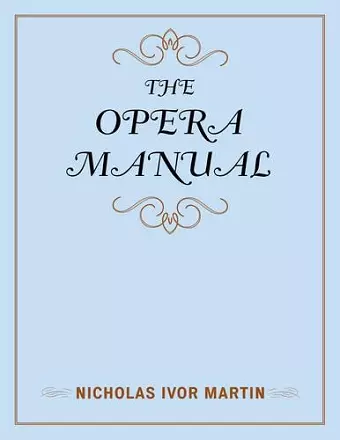The Opera Manual
Format:Hardback
Publisher:Scarecrow Press
Published:30th Oct '13
Currently unavailable, and unfortunately no date known when it will be back

You are getting ready for a performance of Donizetti’s L’elisir d’amore and you have a few questions. How many clarinets are in the orchestra? How many orchestra members appear onstage? How many different sets are there? How long does the opera typically run? What are the key arias? Are any special effects or ballet choreography required? Who owns the rights? Where was it premiered? What are the leading and supporting roles? The Opera Manual is the only single source for the answers to these and other important questions. It is the ultimate companion for opera lovers, professionals, scholars, and teachers, featuring comprehensive information about, and plot summaries for, more than 550 operas—including every opera that is likely to be performed today, from standard to rediscovered contemporary works. The book is invaluable, especially for opera professionals, who will find everything they need for choosing and staging operas. But it is also a treasure for listeners. Similar reference books commonly skip over scenes and supporting characters in their plot summaries, lacking even the most basic facts about staging, orchestral, and vocal requirements. The Opera Manual, based on the actual scores of the works discussed, is the only exhaustive, up-to-date opera companion—a “recipe book” that will enable its readers to explore those operas they know and discover new ones to sample and enjoy.
The new edition of The Opera Manual offers unique information for opera singers, producers, and buffs alike. Keeping in the typical style of other opera reference works, author Martin includes brief biographical and historical facts about composers and works as well as synopses. Where he diverges from the norm is in his descriptions and explanations of major, minor, and chorus roles; voice-type makeup of the chorus; orchestration details; and descriptions of each scene. He also includes useful indexes of librettists and aria titles. Recommended for academic libraries serving music programs and public libraries where there is a strong interest in opera. * Booklist *
Martin, an administrator at Chicago's Lyric Opera, has compiled a volume of technical information useful primarily to persons seeking data on the physical facets of opera production–a 'cookbook,' so to speak. It provides much practical advice on sets, acts/scenes, length, arias (plus vocal proficiency), hazards, chorus parts, accompanying ensemble needs, and more. This new edition follows closely in format Quaintance Eaton's two-volume Opera Production (1961-74) and, of course, has newer repertory in its listings. The text is arranged alphabetically by title of the work, with indexes of arias, librettists, and one-act operas. For the general researcher, this compact work can be used as a source for clearly written plot précis and factual information about a work. . . .Summing Up: Recommended. Professionals/practitioners and general readers. * CHOICE *
The original edition of this work was published in 1998 as The Da Capo Opera Manual. The author of both editions is the director of operations at the Lyric Opera in Chicago, and he refers to the work as an opera 'cookbook' because it lists all the ingredients needed to produce each of the 550 operas contained within. The operas included fall into several categories: standard repertory works, all works by major composers, works by major non-opera composers, works that were once very popular, and small-scale works frequently staged by schools. The entries themselves, listed by title, are rich in details, relaying for each opera: composer, librettist, language, story source, premier date, revision notes, setting, running time, number of sets and scenes, difficult stagings, rights and publisher info, arias, major and minor roles, bit parts, chorus parts, dance parts and instrumentation breakdown for the orchestra. A very brief summary is provided for each scene. . . .This book aims to help a producer stage an opera by gathering all the 'ingredients' needed. It answers such questions as: where to get the rights, how many clarinetists or dancers or choral members are required, and what type of challenging sets and actions have to be planned. . . .[I]t is a godsend for those working in the opera world. The book also lists the operas by title and composer as well as including a separate register of one-act operas. . . .In addition, operas are indexed by librettist, and arias are indexed by voice type. This no-nonsense work packs a lot of basic details into one volume and would be useful for any library that supports either opera students or an opera production team. * American Reference Books Annual *
It is a thorough guide to a large number of operas, designed to support those planning a performance or production both in selecting a work appropriate to the forces available or to be able to check quickly what is required in terms of chorus, orchestra, soloists and stage management. . . .The book is a fine example of a resource not replicated on the Internet and a handy guide for major music libraries. . . .[I]t is a well-researched work of reference of the type still needed in book format. * s *
Nicholas Martin’s book is unique in that it gives invaluable information not only to the non-professional music lover but also to almost everyone who is actively involved in opera producing. It is extraordinarily researched and detailed and, in my opinion, belongs on the bookshelf of anyone who has the slightest interest in opera. -- Sam Ramney, internationally acclaimed bass
Thorough, accurate, and indispensable took for all opera professionals. -- Bruno Bartoletti, artistic director and conductor, Lyric Opera of Chicago
ISBN: 9780810888685
Dimensions: 284mm x 225mm x 35mm
Weight: 1556g
480 pages